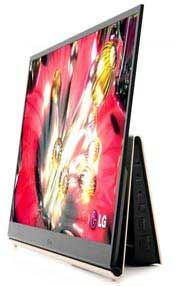Flat-Panel TVs: 10 Things to Know Before You Buy

The world of flat-panel TV technology is evolving rapidly. But it's not all about having the latest, greatest technology. Before you decide which type is right for you, there are several things you should know.
1. There are two varieties: plasma and LCD.
They differ in how they produce the screen pixels — those tiny dots that make up an image. Plasma works by using plasma (ionized gas) to excite phosphor to emit light. LCD units rely on tiny liquid crystal shutters that turn on and off, revealing (and coloring) the backlight.
Since each plasma pixel emits its own light, plasma screens can often have brighter colors and, contrastingly, darker blacks. LCD units, however, use less power.
But characteristics differ widely between brands and models, so technology does not tell the whole tale. In the current market, the main difference between the two is that plasma is commoner in the larger screen sizes.
2. LCD is evolving.
Lately LCD has split into two camps, the original variety using cold cathode fluorescent lamp (CCFL) backlighting, and the new LED LCD units using light-emitting diodes for backlighting. The LEDs may be lined up around the perimeter of the screen, or placed directly behind each LCD. LED LCD units are more energy efficient than first-generation LCD units, and can be thinner — in the range of 1.2 inches, instead of 3 inches.
Sign up for the Live Science daily newsletter now
Get the world’s most fascinating discoveries delivered straight to your inbox.
The Holy Grail is OLED (organic LED) displays, which dispense with the LCD layer and use a separate paper-thin LED for each pixel. These are common in small screens (i.e., cell phones, MP3 player, and digital cameras) but have proven difficult to make in TV sizes.
3. Size matters.
Bigger screens cost more—but you knew that. Keep in mind, though, that screen sizes are measured diagonally. What's available in the stores start under 20 inches and peak somewhere over 65 inches. Units have been made that are larger than 100 inches, but if you have to ask the price, you can't afford it.
If you don't have access to HD programming, a larger screen will do little more than remind you that you don't have access to HD programming.
4. Resolution matters (somewhat).
Typical resolution, by far, is 1080p, meaning that there are 1,080 lines of pixels on the screen, displayed progressively (one line after the next.) If you are certain that you will never get HD programming, then you might pick a smaller unit with a resolution of 720p. But, remember, few things are certain in life.
5. Check for contrast.
When you see them lined up side by side in the store, you'll see that a big differentiator is not so much color but darkness—can the screen produce a black that is truly black? Plasma has the reputation of being better at this, but some LCDs rival it, especially those using the latest LED LCD technology.
6. Check for blurring.
Meanwhile, when the image involves movement, does it leave a blur? You especially don't want any hint of blurring if you plan to use the unit to play video games. This is supposed to be a non-issue with plasma, and should be a minor issue with the latest LCD units.
7. Know your room.
Experts say the best viewing distance is between 1.5 to 3 times the diagonal screen measurement, so big screens demand big rooms. Meanwhile, LCD units do better in brighter rooms since their screens are less reflective — usually. Anyway, there are always curtains.
8. They're durable.
Both plasma and LCD units should remain usable until the screen brightness fades by 50 percent, and that is expected to take 20 years. Permanent after-images, created by displaying a still picture for hours, are rarely an issue any more.
9. Hollywood loves them.
Flat panel TVs have a different aspect ratio (a rectangular 16:9) than the old-style CRT TVs (a nearly square 4:3). The flat-panel aspect ratio is nearly the same as that used by Hollywood movies since the 1950s, so that modern movies can be shown as-is. When broadcast on TV, such movies often have to be edited so that the scene pans back and forth between whoever is speaking, if they don’t both fit on the "small screen" at the same time. As for majestic vistas, forget it.
10. There are alternatives.
At the high end, flat-panel units have competition from rear-projection units using digital light processing (DLP) technology. But being about a foot thick, they don’t qualify as flat-panel units, and they require bright lightbulbs that need replacing at intervals.
Old-style tube TVs, for that matter, are still for sale. They're built around a cathode ray tube (CRT) which excites phosphors on the inside of the screen using an electron beam. That technology, believe it or not, goes back to 1897.
This article was provided by TopTenREVIEWS.












